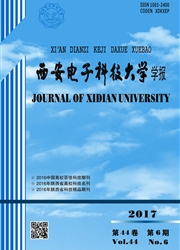

 中文摘要:
中文摘要:
提出了一种基于正交信号的自适应协作无线通信系统.利用二维调制信号的同相和正交分量,每个协作用户同时发送自己和伙伴的数据,形成虚拟的多天线发射机,可在不增加系统带宽和发射功率的情况下,以分布式方式获得发射分集增益.利用译码转发中继信道模型,推导了系统误码率性能的理论表达式,并分析了不同功率分配算法以及协作用户间信道和上行信道传输特性对系统性能的影响.理论分析和仿真结果表明:采用等功率分配算法时,所提系统可获得分集增益,且在用户问信道高信噪比条件下能获得完全分集增益;采用最优功率分配算法可进一步提升协作系统性能.
 英文摘要:
英文摘要:
An adaptive cooperative wireless communication system based on quadrature signaling is proposed, in which each user can transmit its own and the partner's information simultaneously in the inphase and quadrature components of a two-dimension modulated signal. The virtual multiple-antenna transmitter generated in this way allows each user to achieve transmit diversity in a distributed fashion, without expanding the bandwidth and boosting the transmit power. With the decode-and-forward(DF) relay channel model, a closed-form bit error rate(BER) performance expression is derived, and then the effect of different power allocation algorithms together with various inter-user and uplink channel qualities on the system performance is investigated. Simulation results show that the proposed system, with an equal power allocation algorithm, provides diversity gains and can achieve a full diversity order at high inter-user channel signal-to-noise ratios(SNRs). Furthermore, additional performance benefits can be obtained by employing an optimum power allocation algorithm.
 同期刊论文项目
同期刊论文项目
 同项目期刊论文
同项目期刊论文
 The Periodic Half-width Microstrip Leaky-Wave Antenna with a Backward to Forward Scanning Capability
The Periodic Half-width Microstrip Leaky-Wave Antenna with a Backward to Forward Scanning Capability A New Time Domain Solution for the Multiple Diffraction of Spherical Waves by an Array of Nonperfect
A New Time Domain Solution for the Multiple Diffraction of Spherical Waves by an Array of Nonperfect Nonbinary LDPC codes constructed based on a cyclic MDS code and a low-complexity nonbinary message-p
Nonbinary LDPC codes constructed based on a cyclic MDS code and a low-complexity nonbinary message-p Linearly time-varying channel estimation and training power allocation for MIMOOFDM systems using su
Linearly time-varying channel estimation and training power allocation for MIMOOFDM systems using su Linearly Time-Varying Channel Estimation and Symbol Detection for OFDMA Uplink Using Superimposed Tr
Linearly Time-Varying Channel Estimation and Symbol Detection for OFDMA Uplink Using Superimposed Tr Optimal Estimation of Linearly Time-Varying MIMO/OFDM Channels Modeled by a Complex Exponential Basi
Optimal Estimation of Linearly Time-Varying MIMO/OFDM Channels Modeled by a Complex Exponential Basi 期刊信息
期刊信息
